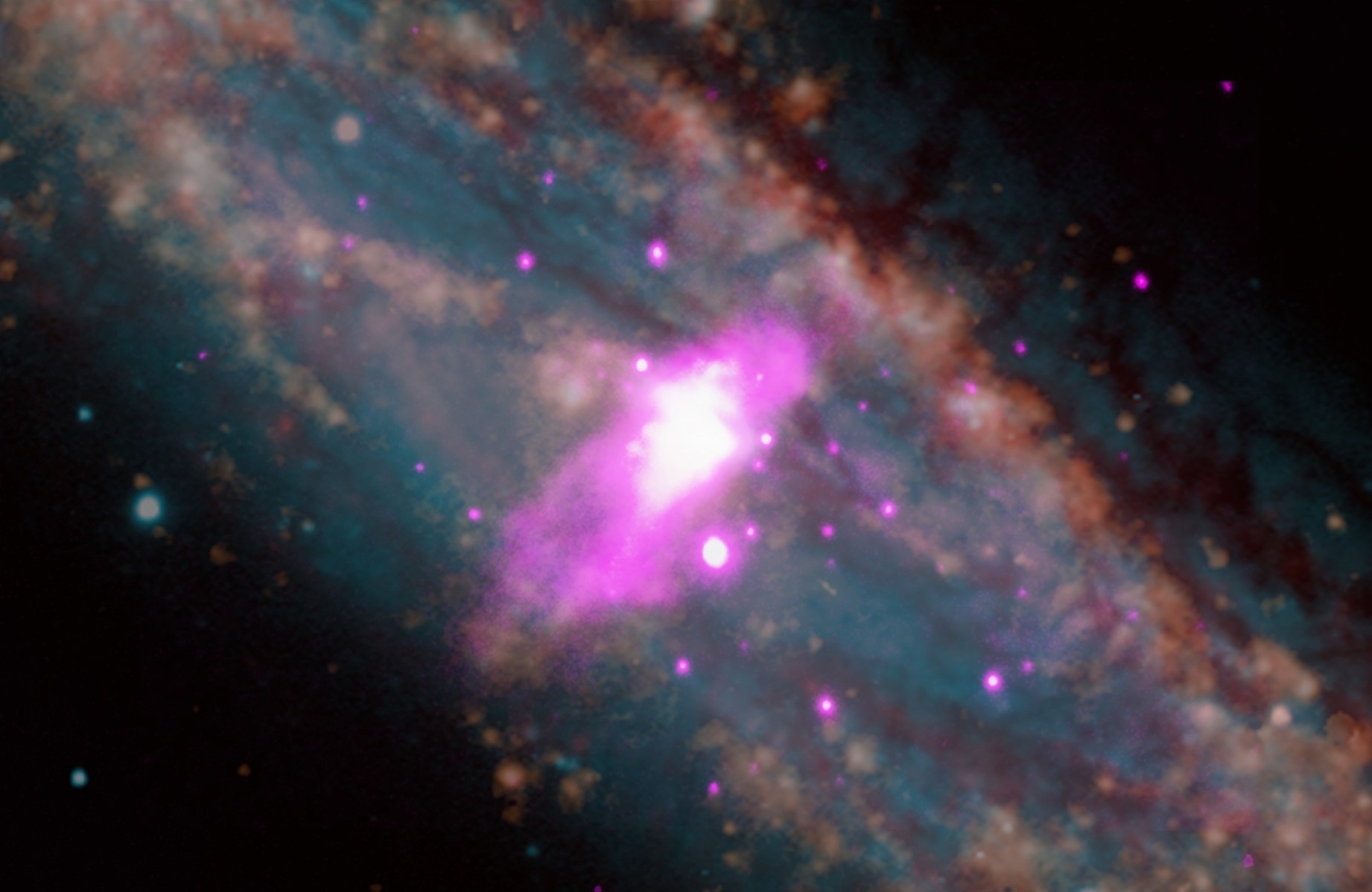Galactic winds—high-powered streams of charged particles and gases—could alter the chemical makeup of the host galaxies they develop in just by blowing in a particular direction.

A composite closeup of the bright center of spiral galaxy NGC 253. Image Credit: X-ray: NASA/CXC/The Ohio State Univ/S. Lopez et al.; H-alpha and Optical: NSF/NOIRLab/AURA/KPNO/CTIO; Infrared: NASA/JPL-Caltech/Spitzer/D. Dale et al; Full Field Optical: ESO/La Silla Observatory
With the help of observations made by NASA’s Chandra X-Ray Observatory, a new study details how such energetic winds, as soon as they are released from the Galaxy’s center, directly impact the metal distribution and temperature of the rest of the region.
Galactic winds are a large part of galaxy evolution in general. As they blow from one end of a galaxy to another, they alter the distribution of metals across the disk and enrich the surrounding intergalactic space.
Sebastian Lopez, Study Lead Author and Graduate Student, Astronomy, The Ohio State University
In examining the spiral galaxy NGC 253, scientists discovered that while the number of such elements can change, the abundance of neon, oxygen, silicon, sulfur, magnesium, and iron peaks in the center of the galaxy and reduces with distance. This shows that as hot gas cools the further away it travels from the center, it avoids a lower concentration of such elements.
Gaining more insights into the celestial detritus that make up such immense galaxies disseminated throughout the cosmos could aid astronomers in more deeply comprehending how galactic formation functions in other areas of the universe.
Our research could reflect that the size of a galaxy, or even its morphology, could impact how gas leaves these systems.
Sebastian Lopez, Study Lead Author and Graduate Student, Astronomy, The Ohio State University
The study was reported online in The Astrophysical Journal.
Between 1999 and 2018, Chandra noted NGC 253 just seven times, but by examining image and spectral data gathered from those observations, Lopez and his group were able to make use of specialized computer software to determine the emission lines left by passing winds.
While collecting this data, they discovered that the research runs counter to earlier X-Ray studies performed on NGC 253, which posit that galactic winds expand in a bubble-like shape or a spherical manner.
Rather, the models Lopez’s group created shows how the winds moves in opposite directions from the middle of the galaxy and further radiates outwards toward the lower left and upper right regions. Lopez blames much of this difference on the data available at the time of the earlier studies and the technological strides researchers have made since then.
The researchers made a comparison of NGC 253 to the outcomes of studies performed on the galaxy M82. This was done to identify how galactic emission differences emerge and if such differences rely on the galaxy’s properties. It is a similar starburst system situated around 12 million light-years away from Earth.
Following the detection of the same metals and similar distributions within M82 that they did with NGC 253, Lopez stated that making a comparison led the team to realize that a process known as charge exchange—the stripping of an electron from a neutral atom by an ion—plays a huge part in the emission of X-Rays.
In order for scientists to create a realistic galaxy in simulations, we need to know where these heavy elements are going. Because if you were to model it and not include charge exchange into these models, they wouldn’t match up.
Sebastian Lopez, lead author of the study and a graduate student in astronomy at The Ohio State University
Lopez said that if such calculations were naturally wrong, researchers would have a hard time making use of their observations to make educated guesses regarding what the universe looks like and how it functions.
However, Lopez predicts that the highly precise models will help astronomers learn about the winds of other galaxies.
Lopez stated, “Next, we want to do this analysis for a larger set of different galaxies and see how things change.”
This study was financially supported by NASA. The study’s co-authors were Laura Lopez, Dustin Nguyen, Todd Thompson, Smita Mathur and Amy Sardone of Ohio State, Alberto Bolatto of the University of Maryland, and Neven Vulic of Eureka Scientific.
Journal Reference
Lopez, S., et al. (2022) X-Ray Properties of NGC 253ʼs Starburst-driven Outflow. The Astrophysical Journal. https://doi.org/10.3847/1538-4357/aca65e.